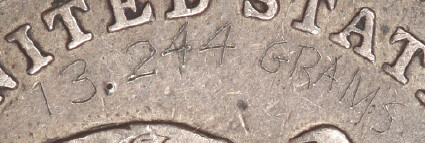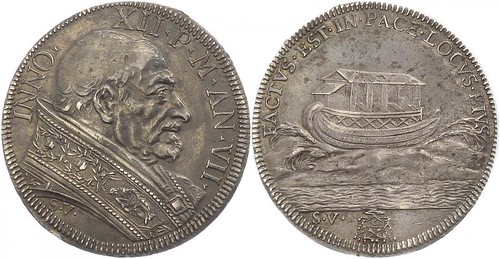
PREV ARTICLE
NEXT ARTICLE
FULL ISSUE
PREV FULL ISSUE
NOTES FROM E-SYLUM READERS: AUGUST 19, 2012 A Theory About the Engraved 1840-O Half Dollar One (remotely) possible explanation for the 1840-O half dollar with its weight engraved upon it might be that when the weight standards of the fractional silver coins were reduced in 1853, some person interested in culling out the older, heavier coins might have taken one of the heavier coins, weighed and marked it, and used that as his standard to sort coins against. This would assume that he was unaware of the Mint's much simpler sorting system of marking the new, lighter coins with arrows at the date, so that any coin without the arrows could be culled out and remelted. We as numismatists all know about the reasons for the arrows, but did the Mint publicize it at the time, or did they keep it secret so that the Treasury Dept. could cull out the older coins for its benefit?

To read the earlier E-Sylum article, see: QUERY: AN ENGRAVED 1840-O HALF DOLLAR (www.coinbooks.org/esylum_v15n33a11.html) A Life-Changing First Cent As to receiving coins of the new year early in the year, on January 6, 1973, I was working as a cashier in Detroit, and I noticed in somebody's deposit a bright, shiny 1973 cent. I replaced it with another, and that night noticed that Frank Gasparro had doubled the size of his initials on the reverse. I stuck it in an envelope and mailed it off to Coin World with this observation, thinking it might merit one paragraph in Collectors Clearinghouse, to which I had already submitted an application for employment. It arrived in the proverbial slow news week, and was splashed across the front page. Later that year when CW was looking for a proofreader with numismatic experience, Margo went through the applications on file and remembered my name from the 1973 cent story. I got the job, and next year transferred to Clearinghouse working for Ed Fleischmann. Later I followed Ed to ANACS, and the rest of my numismatic career followed from that, all because I got a 1973 cent in change on January 6th! To read the earlier E-Sylum article, see: NOTES FROM E-SYLUM READERS: AUGUST 5, 2012: First Coins of the New Year (www.coinbooks.org/esylum_v15n33a08.html) Love Your Numismatic Librarian Have you taken advantage of the great numismatic libraries of the American Numismatic Association or American Numismatic Society? If so, I'd encourage you to nominate a librarian for the American Library Association's 2012 "I love my librarian" award. (For the purposes of these awards, these libraries would be considered "public libraries".) Anyone who does numismatic research would have a much tougher time without these libraries and their librarians (Elizabeth Hahn at ANS & RyAnn Scott at ANA). Whether you have visited the library in person or gotten help via email or phone or only used online resources, you've been helped by their work. Let's show them our appreciation. Nominations are open until September 12. To nominate a librarian, see: atyourlibrary.org/ilovemylibrarian/nominate-your-public-librarian Another Noah's Ark Coin Here's another Noah's Ark coin: 1/2 Piastra AN VII (1697/98), Rome. Muntoni 28

Thanks! This has been an interesting topic.
-Editor
To read the earlier E-Sylum article, see: QUIZ ANSWER: NOAH'S ARK ON COINS (www.coinbooks.org/esylum_v15n34a08.html) On the Origin of Specie
Alan Luedeking forwarded a link to this article from The Economist about Theories on where money comes from. Great title!
-Editor
MONEY is perhaps the most basic building-block in economics. It helps states collect taxes to fund public goods. It allows producers to specialise and reap gains from trade. It is clear what it does, but its origins are a mystery. Some argue that money has its roots in the power of the state. Others claim the origin of money is a purely private matter: it would exist even if governments did not. This debate is long-running but it informs some of the most pressing monetary questions of today. Money fulfils three main functions. First, it must be a medium of exchange, easily traded for goods and services. Second, it must be a store of value, so that it can be saved and used for consumption in the future. Third, it must be a unit of account, a useful measuring-stick. Lots of things can do these jobs. Tea, salt and cattle have all been used as money. In Britain’s prisons, inmates currently favour shower-gel capsules or rosary beads. The use of money stretches back millennia. Electrum, an alloy of gold and silver, was used to make coins in Lydia (now western Turkey) in around 650BC. The first paper money circulated in China in around 1000AD. The Aztecs used cocoa beans as cash until the 12th century. The puzzle is how people agreed what to use.
To read the complete article, see:
On the origin of specie
(www.economist.com/node/21560554)
The Numismatic Bibliomania Society is a non-profit organization promoting numismatic literature. See our web site at coinbooks.org. To submit items for publication in The E-Sylum, write to the Editor at this address: whomren@gmail.com To subscribe go to: https://my.binhost.com/lists/listinfo/esylum All Rights Reserved. NBS Home Page Contact the NBS webmaster 
|